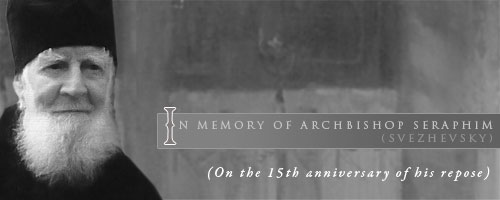In Memory of Late Archbishop Seraphim (Svezhevsky)
Russian Church Abroad
From the Editors: On September 13, 1996, retired Archbishop Seraphim (Svezhevsky), formerly of Caracas and Venezuela, died in Novo Diveevo Convent in Nanuet, NY. Vladyka Seraphim was buried at Holy Trinity Monastery in Jordanville, NY. His funeral, held on September 16, was headed by Archbishop Laurus (Shkurla) of Syracuse and Holy Trinity. We offer our readers a brief biography of Vladyka Seraphim.
Konstantin Nikolaevich Svezhevsky was born on August 14, 1899, in the city of Proskurovo in the Kamenets-Podolsk guberniya.
In May, 1909, he passed his entrance exams and enrolled in Odessa Cadet Corps, intending to carry on the family tradition of military service to the Fatherland.
In 1915, a new leader was appointed to the Corps, Grand Duke Konstantin Konstantinovich, and it was renamed the Odessa Corps of Grand Duke Konstantin Konstantinovich. In May, 1916, the young Svezhevsky graduated from the Corps and was received into the Sergiev Artillery School, which was also located in Odessa, and graduated on February 15, 1917. He was then appointed to the 26th Artillery Division and stationed on the Romanian front, where he arrived on March 2, the very day that Tsar Nicholas II abdicated from the throne.
Konstantin Nikolaevich remained at the front until January 1918, when, with a group of fellow soldiers, he returned home. He was awarded the Medal of Stanislav III with sabers and ribbon for active duty. During this time, his parents lived in the city of Rostov the Great, where his father was a military governor. The family then relocated to Ekaterinburg, and at the end of August 1918, Konstantin Nikolaevich moved to Novcherkassk and joined the Volunteer White Army. He was assigned to the armored train “Ofitser” and participated in the capture of Armavir.
In a month and a half, he was transferred to the II Howitzer Battery, formed in Ekaterinograd, which was engaged in military action near Stavropol.
After the rout of the Bolsheviks in the North Caucasus, the battery was attached to the Kuban Division of General Pokrovsky, who was also a graduate of Odessa Cadet Corps.
This division was a part of General Wrangel’s Army, which advanced on Tsaritsyn. Before reaching Tsaritsyn, in the German colony of Sarepta, Konstantin Nikolaevich fell ill with typhus and was unconscious for three weeks in Novocherkassk Hospital. Following his recovery, he returned to his battery in Tsaritsyn.
In October 1919, Konstantin Nikolaevich was sent to Sevastopol to officer’s school, but before graduating he returned to action at the Don Battery in General Morozov’s Division in Perekop.
Konstantin Nikolaevich saw action with this bather in the North Caucasus and in November, together with General Wrangel’s army, fled his homeland, spending time in Constantinople, Lemnos, Bulgaria and Belgium.
After Belgium was occupied by the Germans, Konstantin Nikolaevich moved to Berlin, Germany, where he worked until the end of the war, after which he joined the Monastery of St Job of Pochaev in Munich.
In August, 1947, he was tonsured to the minor schema and given the name Seraphim, and on September 10, 1948, he was ordained by Metropolitan Anastassy (Gribanovsky) to the rank of hierodeacon.
In January 1949, Fr Seraphim moved to Holy Trinity Monastery in Jordanville, NY, and in 1952, was ordained a hieromonk by Archbishop Vitaly (Maximenko).
In 1954, Fr Seraphim graduated from Holy Trinity Seminary, and in 1956, Archbishop Vitaly elevated him to the rank of hegumen. Later that year, Bishop Vitaly (Ustinov) elevated him to the rank of archimandrite.
In 1957, Fr Seraphim was consecrated Bishop of Caracas and Venezuela, a cathedra he occupied for 27 years. From 1968 to 1978, he also ruled the Diocese of Brazil. Ministering to his flock, he noted that they had little knowledge of Holy Scripture, which he then devoted his time to clarifying for them. He wrote a multitude of short explanations of various portions of Holy Scripture, held regular discussions with his flock, tirelessly clarifying the importance of Liturgical and divine service texts. Vladyka Seraphim also provided guidance to his priests, urging them to perform such instruction constantly.
In 1983, Vladyka Seraphim retired, and ended his life at Novo Diveevo Convent in upstate New York.

